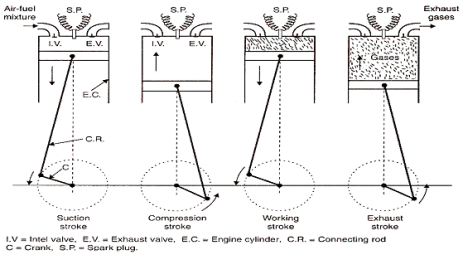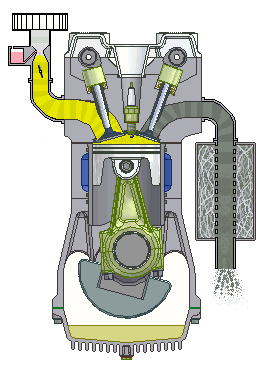Explain the working of four stroke petrol engine with neat sketch.
OR
Explain with diagram how the Four stroke petrol engine works.
Four Stroke petrol engine
FOUR STROKE PETROL ENGINE refers to its use in petrol engines, gas engines, light, oil engine and heavy oil engines in which the mixture of air fuel are drawn in the engine cylinder. Since ignition in these engines is due to a spark, therefore they are also called spark ignition engines. In four stroke cycle engine, cycle is completed in two revolutions of crank shaft or four strokes of the piston. Each stroke consists of 1800 of crankshaft rotation. Therefore, the cycle consists of 7200 of crankshaft rotation.
Cycle consists of following four strokes
1) Suction Stroke
2) Compression Stroke
3) Expansion or Power Stroke
4) Exhaust Stroke
SUCTION STROKE: In this Stroke the inlet valve opens and proportionate fuel-air mixture is sucked in the engine cylinder. Thus the piston moves from top dead centre (T.D.C.) to bottom dead centre (B.D.C.). The exhaust valve remains closed through out the stroke.
COMPRESSION STROKE: In this stroke both the inlet and exhaust valves remain closed during the stroke. The piston moves towards (T.D.C.) and compresses then closed fuel-air mixture drawn. Just before the end of this stroke the operating. plug initiates a spark which ignites the mixture and combustion takes place at constant pressure.

4 stroke petrol engine animation

POWER STROKE OR EXPANSION STROKE: In this stroke both the valves remain closed during the start of this stroke but when the piston just reaches the B.D.C .the exhaust valve opens. When the mixture is ignited by the spark plug the hot gases are produced which drive or throw the piston from T.D.C. to B.D.C. and thus the work is obtained in this stroke.
EXHAUST STROKE: This is the last stroke of the cycle. Here the gases from which the work has been collected become useless after the completion of the expansion stroke and are made to escape through exhaust valve to the atmosphere. This removal of gas is accomplished during this stroke. The piston moves from B.D.C. to T.D.C. and the exhaust gases are driven out of the engine cylinder; this is also called scavenging
A multi cylinder Four stroke petrol engine looks like this.

Links to other pages of power engineering
